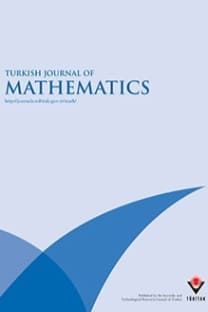A note on the unit distance problem for planar configurations with $\mathbb{Q}$-independent direction set
Unit distance problem, discrete combinatorics, isoperimetric problems
A note on the unit distance problem for planar configurations with $\mathbb{Q}$-independent direction set
___
- Aronov B, Sharir M. Cutting circles into pseudo-segments and improved bounds for incidences. Discrete Comput Geom 2002; 28: 475–490.
- Bernstein AJ. Maximally connected arrays on the n-Cube. SIAM J Appl Math 1967; 15: 1485–1489.
- Bezrukov S. Isoperimetric problems in discrete spaces. In: Frankl P, F¨uredi Z, Katona G, Miklos D, editors. Extremal Problems for Finite Sets. Budapest, Hungary: Bolyai Math Stud, 1994; 3: pp. 59–91.
- Brass P, Moser W, Pach J. Research Problems in Discrete Geometry. New York, NY, USA: Springer-Verlag, 2005.
- Clarkson K, Edelsbrunner H, Guibas L, Sharir M, Welzl E. Combinatorial complexity bounds for arrangements of curves and spheres. Discrete Comput Geom 1990; 5: 99–160.
- Erd¨os P. On a set of distances of n points. Am Math Mon 1946; 53: 248–250.
- Guth L, Katz N. On the Erd¨os distinct distance problem on the plane. arXiv: 1011.4105 [math.CO].
- Harper LH. Optimal assignment of numbers to vertices. J Soc Ind Appl Math 1964; 12: 131–135.
- Hart S. A note on the edges of the n-Cube. Discrete Math 1976; 14: 157–163.
- Matou˘sek J. The number of unit distances is almost linear for most norms. Adv Math 2011; 226: 2618–2628.
- Munkres J. Elements of Algebraic Topology. Menlo Park, CA, USA: Addison-Wesley Publishing Company, 1984.
- Spencer J, Szemer´edi E, Trotter WT. Unit distances in the Euclidean plane. In: Bollobas B, editor. Graph Theory and Combinatorics. New York, NY, USA: Academic Press, 1984, pp. 293–303.
- Sz´ekely L. Crossing numbers and hard Erd¨os problems in discrete geometry. Comb Probab Comput 2005; 6: 353– 358.
- ISSN: 1300-0098
- Yayın Aralığı: 6
- Yayıncı: TÜBİTAK
On Condition (PW P)w for S-posets
Mohammadreza MOLAEI, Hassan MALEKI
On Condition $(PWP)_{w}$ for $S$-posets
A note on the unit distance problem for planar configurations with Q-independent direction set
Jonathan PAKIANATHAN, Mark HERMAN
Mark HERMAN, Jonathan PAKIANATHAN
Magnetic curves on flat para-K\"ahler manifolds
MOHAMED JLELI, MARIAN IOAN MUNTEANU
Jacobi-spectral method for integro-delay differential equations with weakly singular kernels
